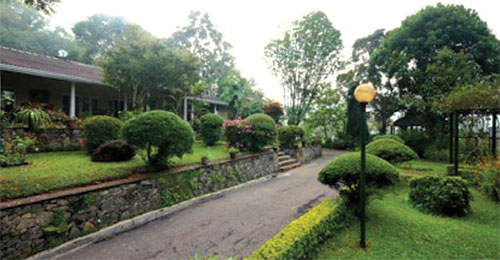Diyatalawa, the 'Watered Plain'
 Diyatalawa, the Watered Plain, was at one point a bare plain where
shrubs and elephants roamed freely. It is believed that British planters
and hunters had come to the area in search of game, resulting in the
extinction of elephants in the region. Moreover, towards the latter part
of the 18th century Wesleyan missionaries, Rev. Samuel Langdon with his
wife, leased the land and set up an orphanage and a school naming the
area 'Happy Valley'. This was later removed to make room for the Boer
war prisoners. Diyatalawa, the Watered Plain, was at one point a bare plain where
shrubs and elephants roamed freely. It is believed that British planters
and hunters had come to the area in search of game, resulting in the
extinction of elephants in the region. Moreover, towards the latter part
of the 18th century Wesleyan missionaries, Rev. Samuel Langdon with his
wife, leased the land and set up an orphanage and a school naming the
area 'Happy Valley'. This was later removed to make room for the Boer
war prisoners.
Annals surrounding the area revolve around the prisoners of the Boer
war, in Africa, who were imprisoned in the locality. Boers, a Dutch word
for farmers, mainly consisted of Dutch descendants that had come to Cape
Town, Africa in the 1600s when the Dutch East India Company operated in
the region.
They made a home for themselves in Cape Town - as the rich and
powerful - driving away or enslaving the natives to gain full advantage
of the city which was located in the navigation route from Amsterdam to
South Asia. As the voyage between the countries took almost three
months, breaking the journey half way to get provisions was customary
and Cape Town proved to be a pivotal city where they were able to gain
many riches.
When the British arrived in Africa they sought to take this wealth
and to take control of the trade route centering Cape Town, leading to
bitter struggles against the British hierarchy. After two successive
wars, in 1877 and 1899, many of the Boers were shipped as prisoners to
other colonies of the British Empire. As such Diyatalawa was chosen as a
place to hold the prisoners and a camp was built in 1900, to house 2,500
prisoners and 1,000 guards. However, more additions were made as the
number of prisoners increased to more than 5,000. For the next few
years, until 1902 when most of the prisoners were released, the camp
was their home where they toiled in building roads among many other
tasks.

With the Independence and the formation of the Ceylon Army in October
10, 1949 the area was established as a training centre for the Sri Lanka
Army.
Hued in green, these abodes offered a glimpse of the way of life some
100 years back.Today Diyatalawa is home to the Sri Lanka Military
Academy, Sri Lanka Air Force, Institute of Surveying and Mapping and a
small thriving town. As we passed the town teeming with many shops,
vehicles and people, it depicted a vibrant setting.
At the Institute of Surveying and Mapping we took time to observe the
structures made out of tin sheets. Hued in green and numbered, these
were the abodes of the prisoners and offered a glimpse of the way of
life some 100 years back.
The Sri Lanka Military Academy (SLMA), the training centre for
officers as well as other personnel, covered a magnificent expanse that
sprawled along acres of beautiful land. To admire this beauty better, we
stopped by the Halangoda Lake, which was rumoured to have been a
treasure trove for precious gems some years back. The green waters that
reflected the overhead skies as well as the lush greenery that lined the
sides enhanced the charm surrounding the area.
Fox Hill where an image of a fox with HMS Fox and the year 1913
etched in white granite on a green backdrop, stands as a landmark that
could be seen from various points in Diyatalawa. It is said that HMS Fox
(His Majesty's Ship), an old vessel - utilised to convey the Boer war
prisoners to Sri Lanka - that was anchored in the Trincomalee Port due
to repairs, was the inspiration behind this insignia.
Situated nearby to this hill is the Fox Hill racing track, an idea by
Hans Ralf - a German national - and made a reality by the Army in 1993.
Fox Hill super-cross usually held in April, is one of the most prominent
car and bike races in Sri Lanka and attracts nearly 75,000 visitors or
more. The most unique feature of the track is that spectators can
witness the races up close as the elevated grand stand provides a view
of the whole track.
Enjoying the gentle breeze, which imparted a breath of fresh air
along with the picturesque landscape dotted with varying shades of
foliage, we paused at a monument built in 1913 to commemorate the Boer
War Prisoners.
The railway station is believed to have been built somewhere between
1892 and 1893. Though the building and the tracks were renovated through
the years, two iron bars used for a cable car, used in the early 1900s,
still stood there. In addition, stories about a little pub being located
in the vicinity and of how one of the tunnels nearby were built, provide
exciting anecdotes.
Diyatalawa carries a wealth of history and scenery to the curious
traveller
-Internet |

